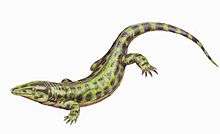Chroniosuchia
| Chroniosuchia Temporal range: Middle Permian–Upper Triassic | |
|---|---|
 | |
| Chroniosuchus | |
| Scientific classification | |
| Kingdom: | Animalia |
| Phylum: | Chordata |
| Clade: | Reptiliomorpha |
| Order: | †Chroniosuchia Kuhn, 1970 |
| Subgroups | |
| Synonyms | |
| |
Chroniosuchia is a group of tetrapods that lived from the Middle Permian to Late Triassic in what is now Eastern Europe, Kyrgyzstan,[1] China and Germany.[2] Chroniosuchians are often thought to be reptiliomorphs,[3] but some recent phylogenetic analyses suggest instead that they are stem-tetrapods.[4] They were all rather short limbed with a strong tail and elongated snout, somewhat resembling modern crocodiles. The group is traditionally considered to be a suborder or order of labyrinthodonts. Chroniosuchians likely had ecological niches as riverside predators, and may have been competed out with the advent of real crocodiles in the late Triassic. Most forms bore a heavy armour of scutes along the back, possibly for protection against land born predators like therapsids, or to strengthen the axial skeleton for terrestrial locomotion. Indeed, femoral microanatomy of Chroniosaurus suggests that it was amphibious to terrestrial.[5]
Description
The most distinguishing features of chroniosuchians are the rows of interlocking bony plates called osteoderms that run along their backs from head to tail. They are the most commonly found remains of chroniosuchians. Each osteoderm is paired with a single vertebra. The osteoderms are flat plates connected to the neural arches of vertebra by an extension of bone on their undersurfaces. The front margin of each osteoderm has a pair of "anterior wings" that slip into a notch in the posterior margin of the osteoderm in front of it.[6]

Chroniosuchians are distinguished from other early reptiliomorphs by the lack of intertemporal bones in the skull, as well as the presence of holes in front of the eye sockets called antorbital fenestrae. Like many early tetrapods, chroniosuchians have vertebrae that are divided into three parts: a pleurocentrum and an intercentrum on the bottom, and a neural arch on top. Chroniosuchians have shizomerous vertebrae, meaning that the pleurocentrum makes up most of the body of the vertebra while the intercentrum is small and wedge-like.[6]
Classification
Taxonomy
- Reptiliomorpha
- Order Chroniosuchia
- Family Bystrowianidae
- Family Chroniosuchidae
Phylogeny
Below is the cladogram showing the preferred phylogeny of Buchwitz et al. (2012):[6]
|
Gallery
See also
References
- 1 2 Rainer R. Schoch, Sebastian Voigt, Michael Buchwitz (2010). "A chroniosuchid from the Triassic of Kyrgyzstan and analysis of chroniosuchian relationships". Zoological Journal of the Linnean Society. 160 (3): 515–530. doi:10.1111/j.1096-3642.2009.00613.x.
- 1 2 Florian Witzmann, Rainer R. Schoch and Michael W. Maisch (2008). "A relict basal tetrapod from Germany: first evidence of a Triassic chroniosuchian outside Russia" (PDF). Naturwissenschaften. 95 (1): 67–72. doi:10.1007/s00114-007-0291-6.
- ↑ Michael Buchwitz, Christian Foth, Ilja Kogan, Sebastian Voigt (2012). "On the use of osteoderm features in a phylogenetic approach on the internal relationships of the Chroniosuchia (Tetrapoda: Reptiliomorpha)". Palaeontology. 55 (3): 623–640. doi:10.1111/j.1475-4983.2012.01137.x.
- ↑ Laurin, M. (2010). How Vertebrates Left the Water. Berkeley, California, USA.: University of California Press. ISBN 978-0-520-26647-6.
- ↑ Laurin, M.; Girondot, M.; Loth, M.M. (2004). "The evolution of long bone microanatomy and lifestyle in lissamphibians". Paleobiology. 30 (4): 589–613. doi:10.1666/0094-8373(2004)030<0589:teolbm>2.0.co;2.
- 1 2 3 Buchwitz, M.; Foth, C.; Kogan, I.; Voigt, S. (2012). "On the use of osteoderm features in a phylogenetic approach on the internal relationships of the Chroniosuchia (Tetrapoda: Reptiliomorpha)". Palaeontology. 55 (3): 623–640. doi:10.1111/j.1475-4983.2012.01137.x.
- 1 2 Jin-Ling Li and Zheng-Wu Cheng (1999). "New Anthracosaur and Temnospondyl Amphibians from Gansu, China - The Fifth Report on Late Permian Dashankou Lower Tetrapod Fauna" (PDF). Vertebrata PalAsiatica. 37 (3): 234–247.
- ↑ V. K. Golubev (1998). "Revision of the Late Permian Chroniosuchians (Amphibia, Anthracosauromorpha) from Eastern Europe" (PDF). Paleontological Journal. 32 (4): 390–401.
- ↑ V. K. Golubev (1998). "Narrow-armored Chroniosuchians (Amphibia, Anthracosauromorpha) from the Late Permian of Eastern Europe" (PDF). Paleontological Journal. 32 (3): 278–287.
- ↑ V. K. Golubev (1999). "A New Narrow-Armored Chroniosuchian (Amphibia, Anthracosauromorpha) from the Upper Permian of Eastern Europe" (PDF). Paleontological Journal. 33 (2): 166–173.




